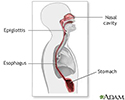Esophageal spasm
Spasm of the esophagus; Distal esophageal spasm; Jackhammer esophagus; AchalasiaEsophageal spasms are abnormal contractions of the muscles in the esophagus, the tube that carries food from the mouth to the stomach. These spasms may not move food effectively to the stomach.
Spasms
Muscle cramps are when a muscle gets tight (contracts) without you trying to tighten it, and it does not relax. Cramps may involve all or part of on...

Causes
The cause of esophageal spasm is unknown. Very hot or very cold foods may trigger spasms in some people. Muscle or nerve problems in the esophagus may cause the spasm.
Symptoms
Symptoms may include:
-
Problems swallowing or pain with swallowing
Problems swallowing
Painful swallowing is any pain or discomfort while swallowing. You may feel it high in the neck or lower down behind the breastbone. Most often, th...
 ImageRead Article Now Book Mark Article
ImageRead Article Now Book Mark Article -
Pain in the chest or upper abdomen
Pain in the chest
Chest pain is discomfort or pain that you feel anywhere along the front of your body between your neck and upper abdomen.
 ImageRead Article Now Book Mark Article
ImageRead Article Now Book Mark Article
It can be hard to tell a spasm from angina pectoris, a symptom of heart disease. The pain may spread to the neck, jaw, arms, or back
Angina
Angina is a type of chest discomfort or pain due to poor blood flow through the blood vessels (coronary arteries) of the heart muscle (myocardium). ...

Exams and Tests
Tests you may need to look for the condition include:
-
Esophagogastroduodenoscopy (EGD)
Esophagogastroduodenoscopy
Esophagogastroduodenoscopy (EGD) is a test to examine the lining of the esophagus, stomach, and first part of the small intestine (the duodenum)....
 ImageRead Article Now Book Mark Article
ImageRead Article Now Book Mark Article -
Esophageal manometry
Esophageal manometry
Esophageal manometry is a test to measure how well the esophagus is working.
 ImageRead Article Now Book Mark Article
ImageRead Article Now Book Mark Article - Esophagogram (barium swallow x-ray)
- Heart evaluation if there is concern that the spasm sensation stems from heart disease
Treatment
Nitroglycerin given under the tongue (sublingual) may help a sudden episode of esophageal spasm. Long-acting nitroglycerin and calcium channel blockers are also used for the problem.
Long-term (chronic) cases are sometimes treated with low-dose antidepressants such as trazodone or nortriptyline to reduce symptoms.
Occasionally, spasm may improve with medicines that block acid production.
Botulinum toxin injections may be done into the esophagus for some conditions that may cause esophageal spasm, such as achalasia, and for distal esophageal spasm.
Rarely, certain cases may need dilation (widening) of the esophagus by endoscopic myotomy (cutting the affected muscles in the esophagus). Surgery may be needed to control symptoms in the case of spastic achalasia.
Outlook (Prognosis)
An esophageal spasm may come and go (intermittent) or last for a long time (chronic). Medicine can help relieve symptoms in many cases. However, other treatments may be needed, especially in the case of achalasia.
Chronic)
Chronic refers to something that continues over an extended period of time. A chronic condition is usually long-lasting and does not easily or quick...

Possible Complications
The condition may not respond to treatment.
When to Contact a Medical Professional
Contact your health care provider if you have symptoms of esophageal spasm that don't go away. The symptoms may actually be due to heart problems. Your provider can help decide if you need heart tests.
Prevention
Avoid very hot or very cold foods if you get esophageal spasms. If the spasm also causes trouble swallowing, avoiding difficult foods such as meat, dry breads, and rice may help.
References
Falk GW, Katzka DA. Diseases of the esophagus. In: Goldman L, Cooney KA, eds. Goldman-Cecil Medicine. 27th ed. Philadelphia, PA: Elsevier; 2024:chap 124.
Pandolfino JE, Kahrilas PJ. Esophageal neuromuscular function and motility disorders. In: Feldman M, Friedman LS, Brandt LJ, eds. Sleisenger and Fordtran's Gastrointestinal and Liver Disease. 11th ed. Philadelphia, PA: Elsevier; 2021:chap 44.
-
Digestive system - illustration
The esophagus, stomach, large and small intestine, aided by the liver, gallbladder and pancreas convert the nutritive components of food into energy and break down the non-nutritive components into waste to be excreted.
Digestive system
illustration
-
Throat anatomy - illustration
Structures of the throat include the esophagus, trachea, epiglottis and tonsils.
Throat anatomy
illustration
-
Esophagus - illustration
The esophagus connects the nose and mouth with the stomach. The epiglottis folds over the trachea when a swallow occurs, to prevent the swallowed substance from being inhaled into the lungs. When a person is unable to swallow because of illness or coma, a tube may be inserted either through the mouth or nose, past the epiglottis, into the esophagus and into the stomach. Nutrients will be passed through the tube directly into the stomach.
Esophagus
illustration
-
Digestive system - illustration
The esophagus, stomach, large and small intestine, aided by the liver, gallbladder and pancreas convert the nutritive components of food into energy and break down the non-nutritive components into waste to be excreted.
Digestive system
illustration
-
Throat anatomy - illustration
Structures of the throat include the esophagus, trachea, epiglottis and tonsils.
Throat anatomy
illustration
-
Esophagus - illustration
The esophagus connects the nose and mouth with the stomach. The epiglottis folds over the trachea when a swallow occurs, to prevent the swallowed substance from being inhaled into the lungs. When a person is unable to swallow because of illness or coma, a tube may be inserted either through the mouth or nose, past the epiglottis, into the esophagus and into the stomach. Nutrients will be passed through the tube directly into the stomach.
Esophagus
illustration
Review Date: 10/30/2024
Reviewed By: Jenifer K. Lehrer, MD, Gastroenterologist, Philadelphia, PA. Review provided by VeriMed Healthcare Network. Also reviewed by David C. Dugdale, MD, Medical Director, Brenda Conaway, Editorial Director, and the A.D.A.M. Editorial team.




